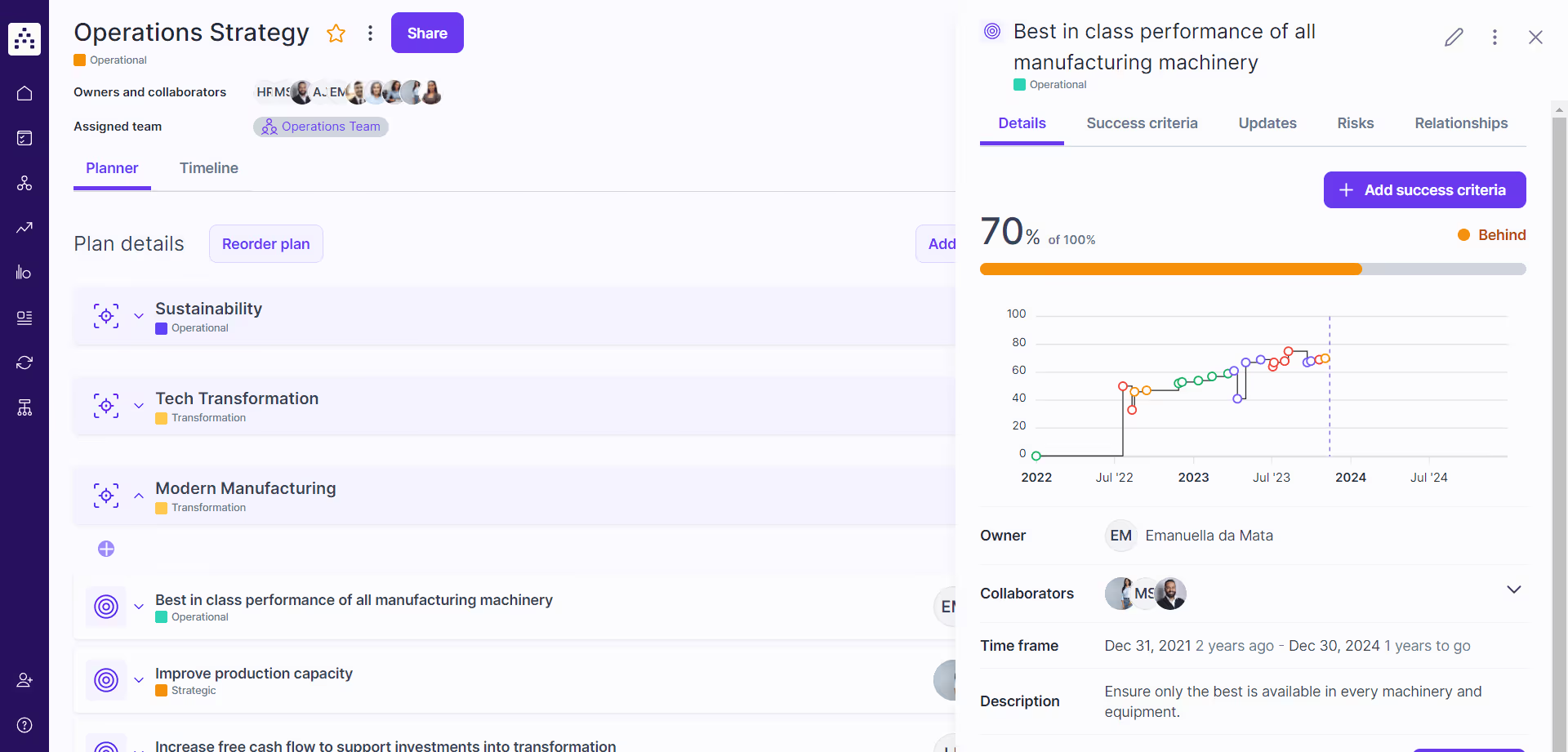Looking to learn the difference between strategic and operational planning and how to get better at each?
You’re in the right place.
In this guide, you’ll discover the key differences and how to keep up with the immediacy of operational tasks without losing sight of the strategic direction for maximized operational efficiency.
We’ll cover:
- What Is The Difference Between Strategic Planning And Operational Planning?
- The 4 Key Traits Of An Effective Operational Plan
- Strategic And Operational Plan Example
What Is The Difference Between Strategic Planning And Operational Planning?
💡Strategic planning sets an organization's long-term direction and goals, considering market trends, business needs, and internal resources. Operational planning breaks down organizational goals into day-to-day activities and short-term objectives. The former establishes the high-level, organization-wide strategy, while the latter manages the roadmap to achieve it.
Let’s dive deeper by taking a closer look at the differences between strategic and operational planning.

What Is Strategic Planning?
Strategic planning is the process by which an organization defines its strategy or direction and decides upon the allocation of its resources to pursue this strategy. It includes a high-level approach that shapes the organization's vision and long-term business goals to ensure its growth and position in the market.
Responsibility for strategic planning rests with top-level management, including CEOs and Boards of Directors. These executives need to consider a variety of external factors—like market trends, economic conditions, and the competitive environment—as well as internal organizational capabilities and resources.
Strategic plan is typically reviewed annually or when major market shifts occur. Its planning time frame generally spans across the next three to five years.
📚Recommended read: Develop An Iterative Strategic Planning Process (+Template)
What Is Operational Planning?
Operational planning outlines the execution of your strategic plan. It includes specific, short-term actions, projects, and initiatives that contribute to achieving strategic objectives.
%20(1).avif)
The responsibility for creating these operational plans rests with middle management and department heads. They are tasked with detailing the actions required to achieve the overall objectives and managing the allocation of resources to hit these targets.
Focusing on the immediate, day-to-day business operations, operational plans are generally developed for the current fiscal year and may be broken down further into quarters or monthly objectives.
To maintain alignment with long-term goals, operational plans need regular reviews and updates, ideally on a quarterly or monthly basis.
📚Recommended read: How To Create An Effective Annual Operating Plan (+Template)
The 4 Key Traits Of An Effective Operational Plan
Here are some things you should consider both during and after your operational planning process to succeed in bridging the gap between the business strategy and operations:
Execution-ready
An effective operational plan is aligned with the strategic initiatives, but most importantly, it’s executable. To ensure your operational plan's success, increase accountability and focus of your team.
One effective way of doing this is to define one specific owner for every project, KPI, goal, or objective in your plan. That person will be responsible for the timely completion of the item. They might have contributors and a team working to achieve it, but they’ll be the ones responsible for its progress.
👉How Cascade helps you:
In Cascade, you can easily assign one (or more owners) to a specific initiative, project, or KPI. You can also add key milestones that should be achieved. This helps you enforce accountability and ensure everyone knows their responsibilities.
Communicated
Successful execution of an operational plan requires that all team members are fully briefed on their roles and the plan's objectives. It must be documented clearly and shared on accessible platforms for easy reference.
Regular meetings or messages to check in on progress help keep everyone on the same page. This transparency fosters a collaborative environment where contributions are recognized and roadblocks quickly addressed.
👉How Cascade helps you:
With Cascade, you can build your operational plans with structure and ease by breaking down complexity into executable outcomes. You can bring in your different teams to speed up the collaboration and source progress updates to observe the execution of your operational plan in real time.
%20(1).png)
Aligned
The main goal of an operational plan is to make the strategic objectives a reality. Creating a regional or departmental operational plan that doesn’t align with organizational goals costs time and money.
It takes up resources and splits the company’s efforts towards two (or multiple) distinct destinations. Aligning the entire organization with the company’s long-term vision and strategic goals is the toughest challenge large corporations face for one main reason.
Most tools that most companies use are ineffective. Excel sheets and slides lack the dynamic properties to align actions and metrics with business objectives and goals. Updating these documents and redistributing them inside the organization takes weeks. Companies can’t afford this kind of delay in internal communication.
👉How Cascade helps you:
With Cascade’s Alignment & Relationships, you can visualize how your corporate strategy breaks down into operational and tactical plans. It allows you to directly link crucial business metrics and initiatives. By doing so, you can quickly identify misaligned initiatives and proactively address risks before it’s too late.
Monitored and evaluated
Success of an operational plan is not guaranteed by the plan itself. What matters is the ongoing diligence in monitoring and evaluating its execution.
In larger organizations, this approach usually meets four challenges:
- Static reporting tools like Excel cannot provide instant insights.
- Departmental silos impede the free flow of information, essential for a holistic view of operations and real-time evaluations.
- Disconnected business software systems complicate the real-time collection and analysis of data.
- Irregular and unstructured review meetings often miss the mark, concentrating on daily tasks rather than strategic alignment and key performance indicators (KPIs).
All of the above lead to delays and make the information less useful for real-time decision-making.
One way to get better at keeping execution on track is to build better reviewing habits on every organizational level. Run strategy review meetings on a quarterly or monthly basis. This is crucial to see actual results like improved accountability and focused execution.
To make that habit stick, though, you’ll need to make it frictionless. For example, minimize the time it takes to collect data and build reports.
👉How Cascade helps you:
With Cascade’s integrations, you can consolidate all your business systems and data sources in one place.
Once you have all data centralized, you can use Reports and Dashboards to get an accurate and real-time picture of your organization’s performance. This will help you to quickly diagnose where you stand today and make fast, confident decisions.
See how Cascade Strategy Execution Platform enhances operational efficiency by reducing duplication and aligning teams toward common goals. It effectively eliminates waste caused by misalignment, fostering smoother operations and improved performance.
Strategic And Operational Plan Example
What should an alignment between the overarching strategic plan and operational plans look like in practice? Here’s an example using Cascade’s Alignment Map. This map shows how operational plans are connected to, and support, the company's main objectives and primary focus areas within the strategic plan.

Now, let's zoom in and examine a specific operational plan:

In the example above, each strategic focus area contains several objectives. Each of these objectives breaks down into goals, projects, and KPIs. Every goal or project has a defined deadline, each KPI has a target value, and there is a designated owner responsible for achieving it. This granularity is crucial for any effective plan.
The aim of using a dynamic digital environment for your strategy and operations is twofold: to enable real-time visibility and to decrease the number of tools used in the process.
A static graph showing how departmental plans align, without displaying their progress in real-time, is of little to no use.
What's the benefit of having three projects and their respective KPIs contribute to a higher-level KPI if updates to the children KPIs don't automatically reflect in the parent KPI?
Digitizing your operational plan addresses these inefficient activities by centralizing all information in one place.
Use Cascade To Centralize Your Strategy 🚀
Traditional approach to corporate strategy and planning often falters as it keeps strategy and operations in separate silos, struggling to synchronize them, particularly in larger organizations. Operational plan lags, failing to mirror rapid strategic shifts, and senior management is distanced from the frontline.
How can one expect spreadsheets and presentations to align thousands of employees worldwide? And how can leaders effectively manage business performance without a current snapshot of operations?
This alignment is impossible with static tools. Your strategy and operational plan must exist together in a centralized strategy execution platform like Cascade to bridge that gap.
Want to give it a try? Sign up today for free or book a 1:1 product tour with one of Cascade’s strategy experts.
FAQ
What is the difference between business planning, strategic planning, and operational planning?
Business planning outlines a company's go-to-market plan, financial projections, market research, and business purpose. Strategic planning is focused on determining the organization's long-term goals and objectives. Operational planning is the process of breaking down the goals and objectives into specific tasks and activities that need to be completed in order to achieve them.







.png)
.jpg)
.jpg)



